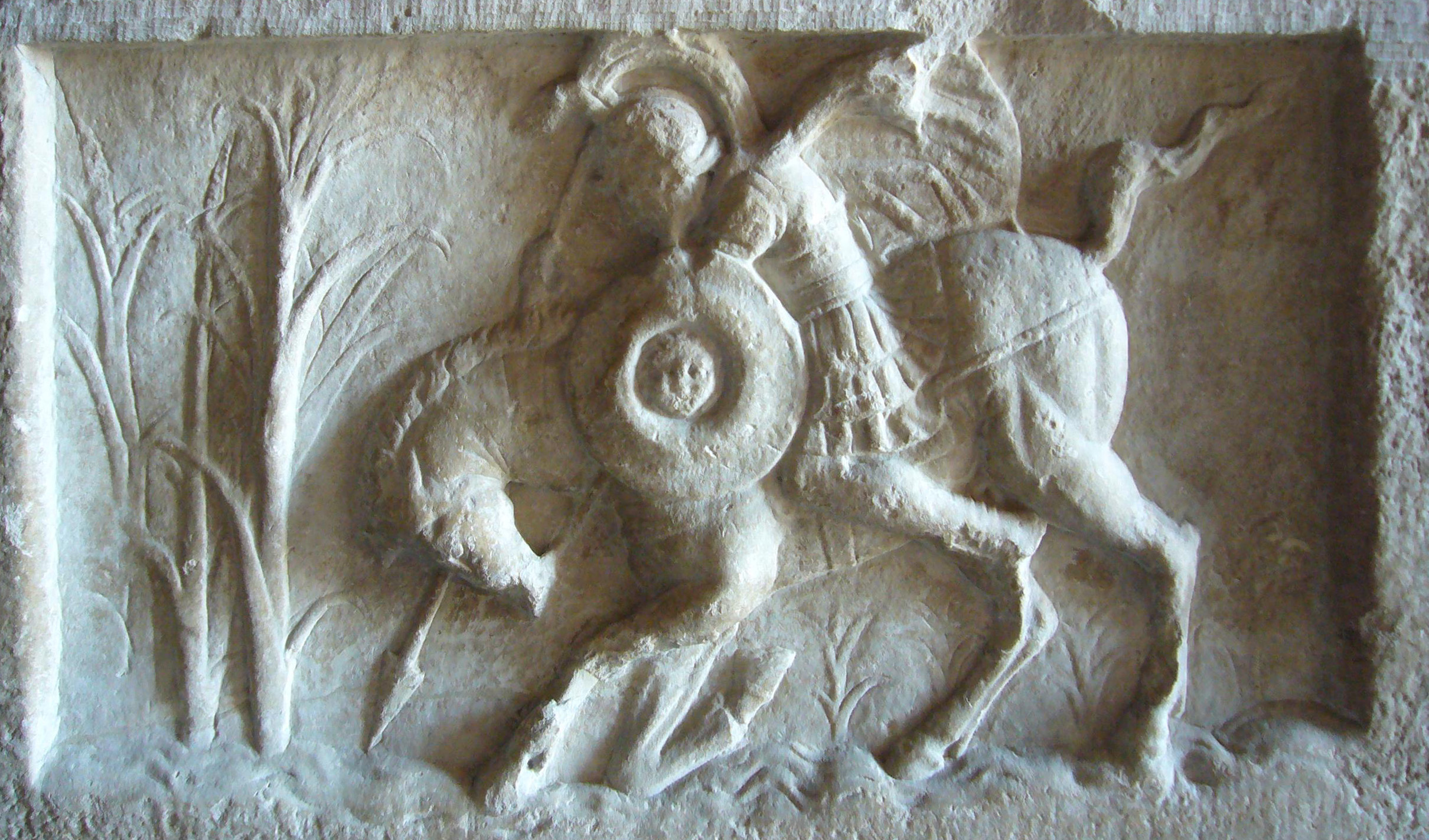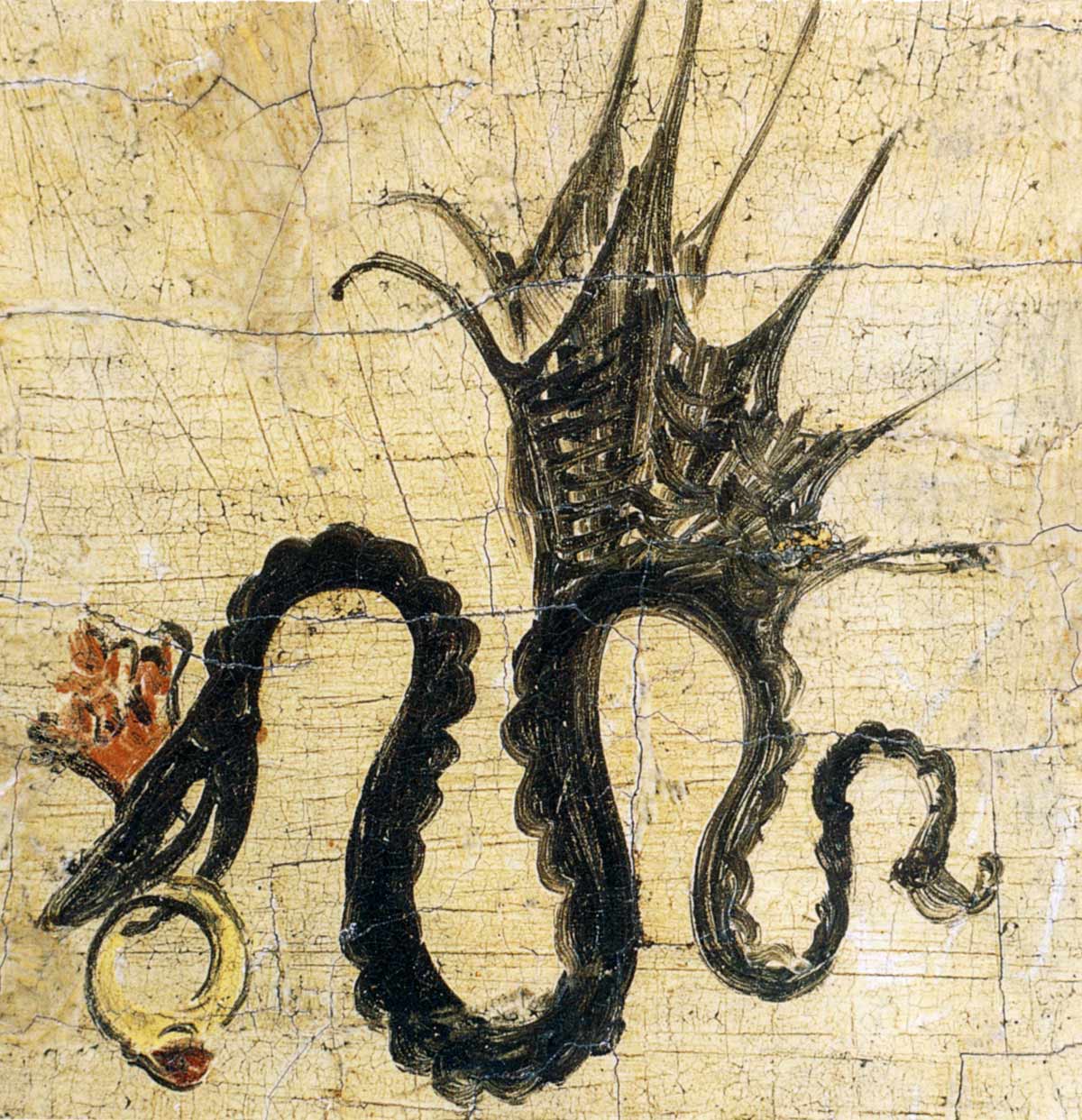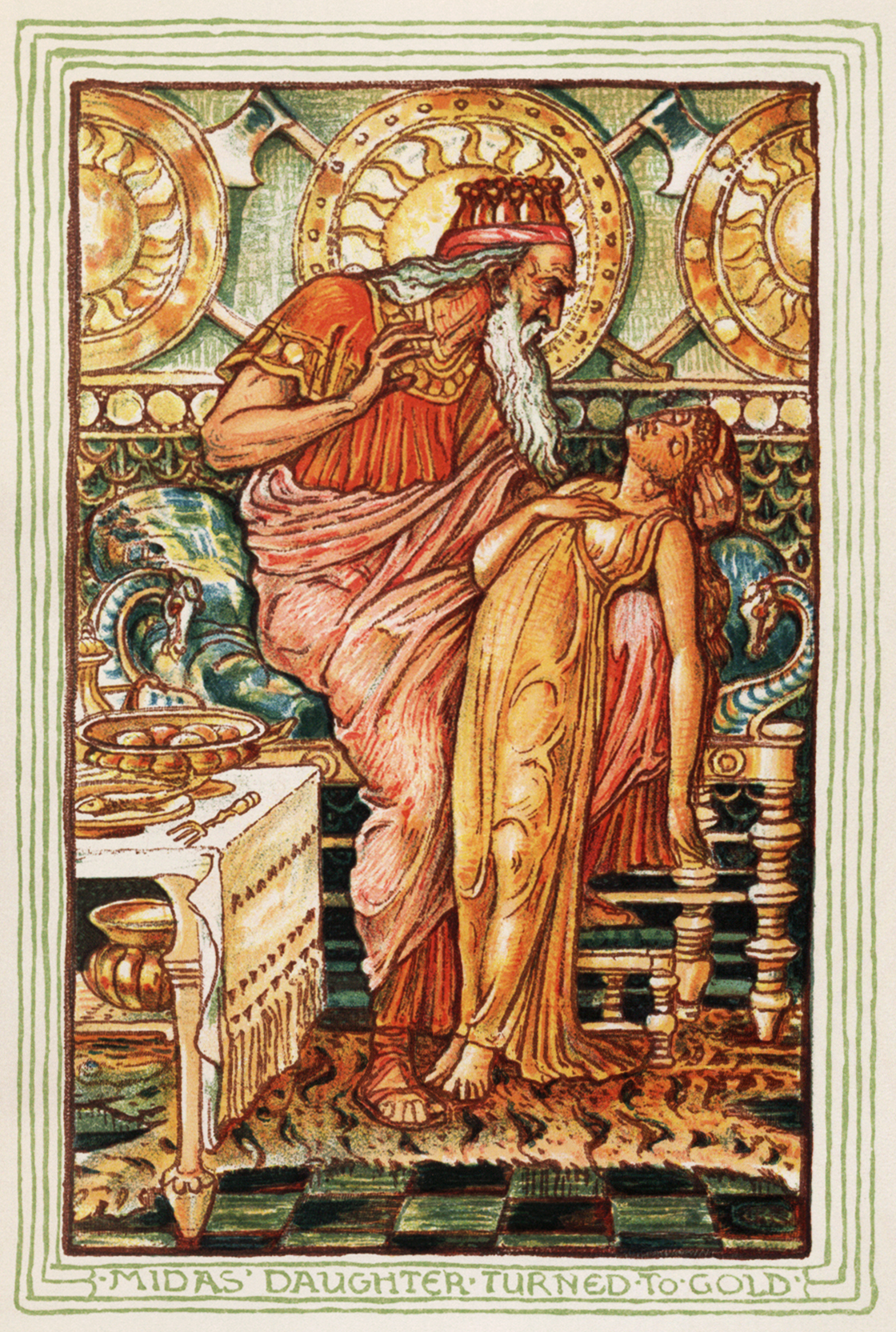|
Lacus Curtius
The Lacus Curtius ("Lake Curtius") was a mysterious pit or pool in the ground in the Forum Romanum. The area where the Forum would later be built was originally likely a lake, as the area it was in is known to have been surrounded by brooks and marshes. One part of the area was never drained, but gradually became smaller until only a basin, known as the Lacus Curtius, was left.Lacus Curtius '''' Its nature and significance in Rome's early history is uncertain, and several conflicting stories exist about its history. The name of the place is likely connected with the |
Marcus Curtius
Marcus Curtius is a mythological young Roman who offered himself to the gods of Hades. He is mentioned shortly by Varro and at length by Livius. He is the legendary namesake of the Lacus Curtius in the Roman Forum, the site of his supposed sacrifice. Legendary biography After an earthquake in 362 BC, a huge deep pit suddenly opened in the Roman Forum, which the Romans attempted to fill in vain. Despairing, they consulted an augur who responded that the gods demanded the most precious possession of Rome. The Romans doubted the warning, and struggled to think of what that was. However, a young soldier named Marcus Curtius castigated them and responded that arms and the courage of Romans were the nation's most precious possessions. Astride his horse, fully and meticulously armed and decorated, Marcus rode and leapt into the chasm. Immediately, the deep pit closed over him, saving Rome. The Lacus Curtius in the Forum was supposedly built on the site of the pit, and receives its na ... [...More Info...] [...Related Items...] OR: [Wikipedia] [Google] [Baidu] |
Curtia Gens
The gens Curtia was an ancient but minor noble family at Rome, with both patrician and plebeian branches. The only member of the gens invested with the consulship under the Republic was Gaius Curtius Philo, in 445 BC. A few Curtii held lesser magistracies during the Republic, and there were two consuls ''suffectus'' in imperial times. However, the gens is best remembered from a series of legends dating from the traditional founding of the city to the early Republic. Origin According to legend, Mettius Curtius was a leader of the Sabine forces who attacked Rome following the Rape of the Sabine Women. The first blows were exchanged between Curtius and the Roman warrior, Hostus Hostilius. After fierce fighting, Hostilius was slain and the Romans retreated, pursued by Curtius. Just then, the Roman King, Romulus, led his best troops against Curtius' advance. Pursued by the Romans, Curtius' horse was frightened by the shouting and plunged into the swamps, becoming mired in shallow ... [...More Info...] [...Related Items...] OR: [Wikipedia] [Google] [Baidu] |
Curtia Gens
The gens Curtia was an ancient but minor noble family at Rome, with both patrician and plebeian branches. The only member of the gens invested with the consulship under the Republic was Gaius Curtius Philo, in 445 BC. A few Curtii held lesser magistracies during the Republic, and there were two consuls ''suffectus'' in imperial times. However, the gens is best remembered from a series of legends dating from the traditional founding of the city to the early Republic. Origin According to legend, Mettius Curtius was a leader of the Sabine forces who attacked Rome following the Rape of the Sabine Women. The first blows were exchanged between Curtius and the Roman warrior, Hostus Hostilius. After fierce fighting, Hostilius was slain and the Romans retreated, pursued by Curtius. Just then, the Roman King, Romulus, led his best troops against Curtius' advance. Pursued by the Romans, Curtius' horse was frightened by the shouting and plunged into the swamps, becoming mired in shallow ... [...More Info...] [...Related Items...] OR: [Wikipedia] [Google] [Baidu] |
14 Regions Of Augustan Rome
Fourteen or 14 may refer to: * 14 (number), the natural number following 13 and preceding 15 * one of the years 14 BC, AD 14, 1914, 2014 Music * 14th (band), a British electronic music duo * ''14'' (David Garrett album), 2013 *''14'', an unreleased album by Charli XCX * "14" (song), 2007, from ''Courage'' by Paula Cole Other uses * ''Fourteen'' (film), a 2019 American film directed by Dan Sallitt * ''Fourteen'' (play), a 1919 play by Alice Gerstenberg * ''Fourteen'' (manga), a 1990 manga series by Kazuo Umezu * ''14'' (novel), a 2013 science fiction novel by Peter Clines * ''The 14'', a 1973 British drama film directed by David Hemmings * Fourteen, West Virginia, United States, an unincorporated community * Lot Fourteen, redevelopment site in Adelaide, South Australia, previously occupied by the Royal Adelaide Hospital * "The Fourteen", a nickname for NASA Astronaut Group 3 * Fourteen Words, a phrase used by white supremacists and Nazis See also * 1/4 (other) * ... [...More Info...] [...Related Items...] OR: [Wikipedia] [Google] [Baidu] |
Roman Mythology
Roman mythology is the body of myths of ancient Rome as represented in the literature and visual arts of the Romans. One of a wide variety of genres of Roman folklore, ''Roman mythology'' may also refer to the modern study of these representations, and to the subject matter as represented in the literature and art of other cultures in any period. Roman mythology draws from the mythology of the Italic peoples and ultimately from Proto-Indo-European mythology. Roman mythology also draws directly on Greek mythology, potentially as early as Rome's protohistory, but primarily during the Hellenistic period of Greek influence and through the Roman conquest of Greece, via the artistic imitation of Greek literary models by Roman authors. The Romans identified their own gods with those of the ancient Greeks—who were closely historically related in some cases, such as Zeus and Jupiter—and reinterpreted myths about Greek deities under the names of their Roman counterparts. Greek and ... [...More Info...] [...Related Items...] OR: [Wikipedia] [Google] [Baidu] |
Lucas Cranach The Elder
Lucas Cranach the Elder (german: Lucas Cranach der Ältere ; – 16 October 1553) was a German Renaissance painter and printmaker in woodcut and engraving. He was court painter to the Electors of Saxony for most of his career, and is known for his portraits, both of German princes and those of the leaders of the Protestant Reformation, whose cause he embraced with enthusiasm. He was a close friend of Martin Luther. Cranach also painted religious subjects, first in the Catholic tradition, and later trying to find new ways of conveying Lutheran religious concerns in art. He continued throughout his career to paint nude subjects drawn from mythology and religion. Cranach had a large workshop and many of his works exist in different versions; his son Lucas Cranach the Younger and others continued to create versions of his father's works for decades after his death. He has been considered the most successful German artist of his time. Early life He was born at Kronach in uppe ... [...More Info...] [...Related Items...] OR: [Wikipedia] [Google] [Baidu] |
Paolo Veronese
Paolo Caliari (152819 April 1588), known as Paolo Veronese ( , also , ), was an Italian Renaissance painter based in Venice, known for extremely large history paintings of religion and mythology, such as ''The Wedding at Cana'' (1563) and ''The Feast in the House of Levi'' (1573). Included with Titian, a generation older, and Tintoretto, a decade senior, Veronese is one of the "great trio that dominated Venetian painting of the ''cinquecento''" and the Late Renaissance in the 16th century.Rosand, 107 Known as a supreme colorist, and after an early period with Mannerism, Paolo Veronese developed a naturalist style of painting, influenced by Titian. His most famous works are elaborate narrative cycles, executed in a dramatic and colorful style, full of majestic architectural settings and glittering pageantry. His large paintings of biblical feasts, crowded with figures, painted for the refectories of monasteries in Venice and Verona are especially famous, and he was also the leadi ... [...More Info...] [...Related Items...] OR: [Wikipedia] [Google] [Baidu] |
Renaissance Art
Renaissance art (1350 – 1620 AD) is the painting, sculpture, and decorative arts of the period of European history known as the Renaissance, which emerged as a distinct style in Italy in about AD 1400, in parallel with developments which occurred in philosophy, literature, music, science, and technology. Renaissance art took as its foundation the art of Classical antiquity, perceived as the noblest of ancient traditions, but transformed that tradition by absorbing recent developments in the art of Northern Europe and by applying contemporary scientific knowledge. Along with Renaissance humanist philosophy, it spread throughout Europe, affecting both artists and their patrons with the development of new techniques and new artistic sensibilities. For art historians, Renaissance art marks the transition of Europe from the medieval period to the Early Modern age. The body of art, painting, sculpture, architecture, music and literature identified as "Renaissance art" was primar ... [...More Info...] [...Related Items...] OR: [Wikipedia] [Google] [Baidu] |
Lake-burst
A lake-burst ( sga, tomaidm, tomaidm, ga, tomhaidhm, tomhaidhm) is a phenomenon referred to in Irish mythology, in which a previously non-existent lake comes into being, often when a grave is being dug. Part of the lake-burst stories may originate in sudden hydrographic changes around limestone-based inland plains or turloughs. Other so-called lake-bursts refer to marine estuaries, bays and inlets, such as Galway Bay, Strangford Lough, Dundrum Bay, Belfast Lough, Waterford Harbour and the mouth of the River Erne. Some of these coastal districts were renowned for the drowned prehistoric forests, which gave rise to several flood-myths. Medieval bards had a special genre of lake-burst poems called ''tomamond''. More or less elaborate 11th- or 12th-century narratives have survived around Galway Bay, Lough Neagh and Lough Ree, which seem to be related to similar (though less ancient) stories in Wales (Cantre'r Gwaelod, Llys Helig, Bala Lake, Llynclys), Cornwall (Lyonesse), Brittany ( Y ... [...More Info...] [...Related Items...] OR: [Wikipedia] [Google] [Baidu] |
Lapis Niger
The Lapis Niger (Latin, "Black Stone") is an ancient shrine in the Roman Forum. Together with the associated Vulcanal (a sanctuary to Vulcan) it constitutes the only surviving remnants of the old Comitium, an early assembly area that preceded the Forum and is thought to derive from an archaic cult site of the 7th or 8th century BC. The black marble paving (1st century BC) and modern concrete enclosure (early 20th century) of the Lapis Niger overlie an ancient altar and a stone block with one of the earliest known Old Latin inscriptions (c. 570–550 BC). The superstructure monument and shrine may have been built by Julius Caesar during his reorganization of the Forum and Comitium space. Alternatively, this may have been done a generation earlier by Sulla during one of his construction projects around the Curia Hostilia. The site was rediscovered and excavated from 1899 to 1905 by Italian archaeologist Giacomo Boni. Mentioned in many ancient descriptions of the Forum dating b ... [...More Info...] [...Related Items...] OR: [Wikipedia] [Google] [Baidu] |
Midas
Midas (; grc-gre, Μίδας) was the name of a king in Phrygia with whom several myths became associated, as well as two later members of the Phrygian royal house. The most famous King Midas is popularly remembered in Greek mythology for his ability to turn everything he touched into gold. This came to be called the ''golden touch'', or the ''Midas touch''. The legends told about this Midas and his father Gordias, credited with founding the Phrygian capital city Gordium and tying the Gordian Knot, indicate that they were believed to have lived sometime in the 2nd millennium BC, well before the Trojan War. However, Homer does not mention Midas or Gordias, while instead mentioning two other Phrygian kings, Mygdon and Otreus. The Phrygian city Midaeum was presumably named after him, and this is probably also the Midas that according to Pausanias founded Ancyra (today known as Ankara). Another King Midas ruled Phrygia in the late 8th century BC. Most historians believe this M ... [...More Info...] [...Related Items...] OR: [Wikipedia] [Google] [Baidu] |
Ancient Greek
Ancient Greek includes the forms of the Greek language used in ancient Greece and the ancient world from around 1500 BC to 300 BC. It is often roughly divided into the following periods: Mycenaean Greek (), Dark Ages (), the Archaic period (), and the Classical period (). Ancient Greek was the language of Homer and of fifth-century Athenian historians, playwrights, and philosophers. It has contributed many words to English vocabulary and has been a standard subject of study in educational institutions of the Western world since the Renaissance. This article primarily contains information about the Epic and Classical periods of the language. From the Hellenistic period (), Ancient Greek was followed by Koine Greek, which is regarded as a separate historical stage, although its earliest form closely resembles Attic Greek and its latest form approaches Medieval Greek. There were several regional dialects of Ancient Greek, of which Attic Greek developed into Koine. Dia ... [...More Info...] [...Related Items...] OR: [Wikipedia] [Google] [Baidu] |






_2.jpg)

